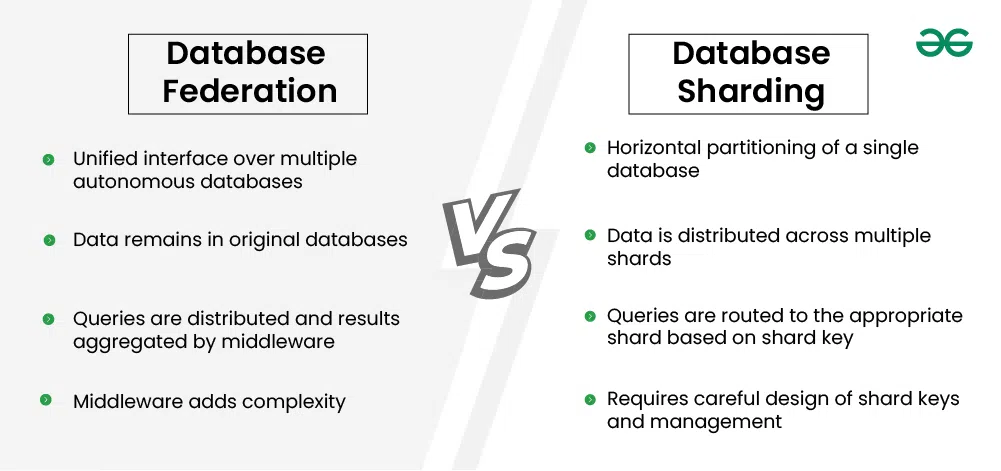|
Scaling databases is critical for handling increasing data volumes. Database Federation and Database Sharding are two approaches that address this challenge differently. This article delves into their distinct methods, applications, and considerations for effectively managing data growth in modern systems.

Important Topics for Database Federation vs. Database Sharding
What is Database Federation?
Database Federation (also known as Federated Database System) is a system that provides a unified interface to access data from multiple autonomous databases. It allows queries to be executed across several databases as if they were a single database, without merging them physically. Some characteristics of Database Federation include:
- Each database remains autonomous.
- Unified query interface for multiple databases.
- Suitable for integrating heterogeneous databases.
- The middleware layer manages query distribution and result aggregation.
What is Database Sharding?
Database Sharding is a method of partitioning a large database into smaller, more manageable pieces called shards. Each shard holds a subset of the total data, and all shards together represent the complete dataset. Sharding is typically done to improve performance and scalability. Some characteristics of Database Sharding include:
- Data is horizontally partitioned across multiple databases.
- Each shard operates independently.
- Helps in managing large datasets efficiently.
- Requires shard key to distribute data across shards.
Database Federation vs. Database Sharding
Below are the difference between Database Federation and Database Sharding:
|
Feature
|
Database Federation
|
Database Sharding
|
|
Architecture
|
Unified interface over multiple autonomous databases
|
Horizontal partitioning of a single database
|
|
Data Distribution
|
Data remains in original databases
|
Data is distributed across multiple shards
|
|
Autonomy
|
Each database remains independent and autonomous
|
Shards are part of the same logical database
|
|
Query Handling
|
Queries are distributed and results aggregated by middleware
|
Queries are routed to the appropriate shard based on shard key
|
|
Use Case
|
Integrating heterogeneous databases, complex queries
|
Handling large datasets, improving performance
|
|
Complexity
|
Middleware adds complexity
|
Requires careful design of shard keys and management
|
|
Scalability
|
Limited by the middleware and underlying databases
|
High scalability by adding more shards
|
|
Consistency
|
Potential issues with consistency and latency
|
Consistency managed within individual shards
|
|
Maintenance
|
More complex due to multiple database systems
|
Easier within shards but complex across shards
|
|
Performance
|
Depends on the middleware and network latency.
|
Typically better performance for large datasets.
|
Applications of Database Federation
Below are the applications of database federation:
- Enterprise Systems: Integrating data from multiple departments with different database systems.
- Data Warehousing: Aggregating data from various sources for reporting and analysis.
- Global Companies: Accessing and integrating data from geographically distributed databases.
- Healthcare: Integrating patient records from different hospitals and clinics.
Applications of Database Sharding
Below are the applications of database sharding:
- Large-scale Web Applications: Social networks, e-commerce platforms, and other high-traffic sites.
- Gaming: Online gaming platforms with a large number of concurrent users.
- Financial Services: Handling large volumes of transaction data.
- IoT: Managing and processing vast amounts of data from IoT devices.
Conclusion
Both Database Federation and Database Sharding offer solutions to handle large amounts of data and improve database performance. The choice between the two depends on the specific needs of the application:
- Database Federation is ideal for integrating disparate databases and providing a unified interface for complex queries across multiple systems.
- Database Sharding is better suited for applications requiring high scalability and performance, particularly where the dataset can be partitioned horizontally.
|

